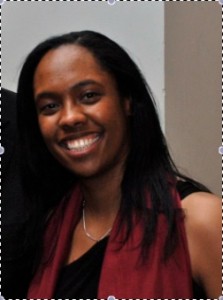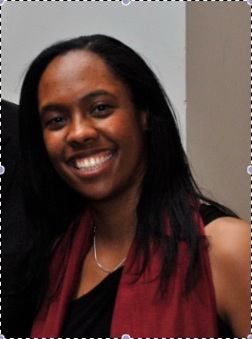Black First – Christina Garrett Klein
 Across communities in the United States and around the world, my primary identifier is that I am black, and not that I am female. It does not matter how I wear my hair, whether I’m wearing make-up or not, or what I wear (unless it’s a dress), because the color of my skin comes before any gender identity and sexual orientation. As a black, cisgender female, I have found gender in the black community, in the white community, and in other communities of color particularly challenging.
Across communities in the United States and around the world, my primary identifier is that I am black, and not that I am female. It does not matter how I wear my hair, whether I’m wearing make-up or not, or what I wear (unless it’s a dress), because the color of my skin comes before any gender identity and sexual orientation. As a black, cisgender female, I have found gender in the black community, in the white community, and in other communities of color particularly challenging.
Within the black community, there are high expectations for women to be and do everything to support the family and the church. We are the ones who cook and clean, catch up with our own families as well as our in-laws, teach our children what race means and culture means in a society that undervalues and dehumanizes us at an age that gets younger and younger, and have a job outside of the home in order to show that black women can do more than cook and nanny in the American society. We are the ones who have to stay strong in any and every situation because if we break and show signs of weakness, our power is compromised.
I think most people are surprised when black people achieve a high status, but it seems especially mystifying when it is a black woman. Last year, I was driving home from my internship congregation when a black SUV pulled up to me at a stoplight. A black male in his mid-40s opened his door and motioned for me to roll down my window, and said, ”So, are you a nun or something? What are you? I’ve never seen a black nun before.” Yes, I did have my collar on, and I wore my hair natural that day, but I didn’t think that this would make me some sort of magical unicorn on a Sunday afternoon. I told him I was a seminary intern studying to be a pastor and he responded, “Alright! More power to you;” then the light turned green.
In the white community, I am categorized as a nice, educated, and assimilated black girl, or a vixen and Jezebel with many baby-daddies who tries to abuse the system. When I say assimilated, I mean in the way I talk, walk, and dress. I have been given many compliments about how articulate and well-spoken I am, which may sound harmless, but often comes off as gender authority: “Thank you for not having the girlish tone of squeaky soprano, Midwest Valley Girl, or vocal fry”; and cultural accommodation: “I’m so glad you speak like us and not Ebonics so I can understand you”.
When considering gender, it always seems that appearances come to the table, especially the Western world’s understanding of beauty. This may be why I am first identified as black and secondarily as female, with my mocha skin, natural curly and kinky hair, and wide hips. Hair is a huge deal in the black community, and it only seems to be another mystery for many in the white community. I cannot begin to count how many times I have lengthened my hair with a straightening iron, then wash it and wear it natural, and friends who I have known and who know me ask if I got my hair cut, and how cute it looks. Other women just want to touch it, wondering whether it’s a weave or a wig, and if it really feels like straw or if it’s as soft as cotton. In these instances, I feel more like a petting zoo animal than a respectable female.
In other communities of color in America, the expectation of black females is similar to that of the dominant community. Again, our appearance seems to take precedence over most things. There are many stereotypes of colorism that make a black female with a dark complexion more threatening than one with a lighter complexion. And while this is true across communities, it seems more explicit in communities of color who use skin-lightening creams or always walk under an umbrella when the sun is out.
In these communities, there is a different take on exotic beauty and power. I walked in to a friend’s birthday party after assisting with a wedding rehearsal in a black blazer with a black shell underneath, a knee-length blue and green skirt with black trim, black tights, and nearly knee high boots. Tiffany said that I was the sexiest thing she had seen. In prior situations, I had seen Tiffany as Jon, a half-Filipino, half-white gay male, but tonight she was giving a sneak peek of her drag show as Tiffany, a Blatina (Black and Latina) who was the epitome of every man’s fantasy. Even in my no-flesh-exposed business attire, Tiffany found me to be the sexiest one in the room and the one whom she aspired to become, in performance only of course.
While I was flattered by the compliment, I was also appalled that I was only a sex object, an exotic body for pleasure-seekers, and not a real person. I am the powerhouse who serves all, the unicorn and the petting zoo animal, and in all of this, I still have to prove my identity, my value, and my worth in a society that treats me as everything except for an equal part of God’s creation . . . as an equal member of God’s family, and as a child of God.
In the Bible, we find the black female within the story of Hagar. She is the dark-skinned woman, the servant used and abused by Sarai as the vessel of Abram’s son Ishmael, and the one cast out into the wilderness when she no longer serves her purpose. There is relief in God’s saving power and promise in the rest of the story, but it is hard to always be that strong black woman we all expect.
—–
Christina Garrett Klein is a student at the Lutheran School of Theology at Chicago, graduating in May. She has been assigned to the Metropolitan Chicago Synod for her first call, and served as a Youth Ministry and Christian Education director prior to seminary.

